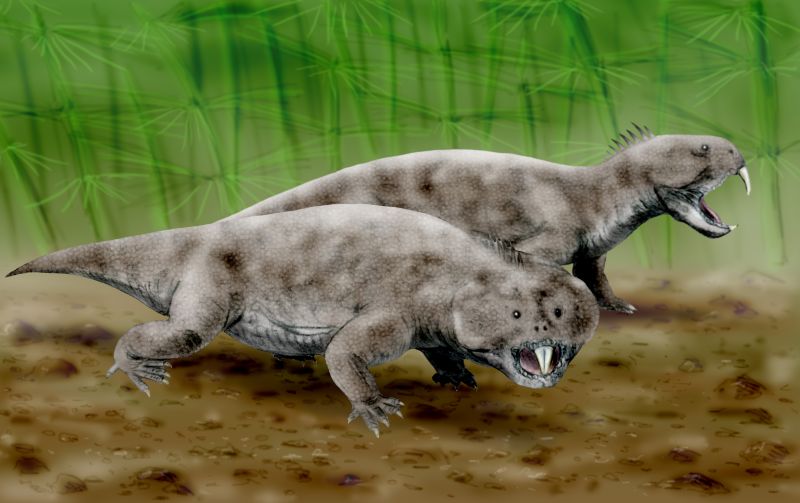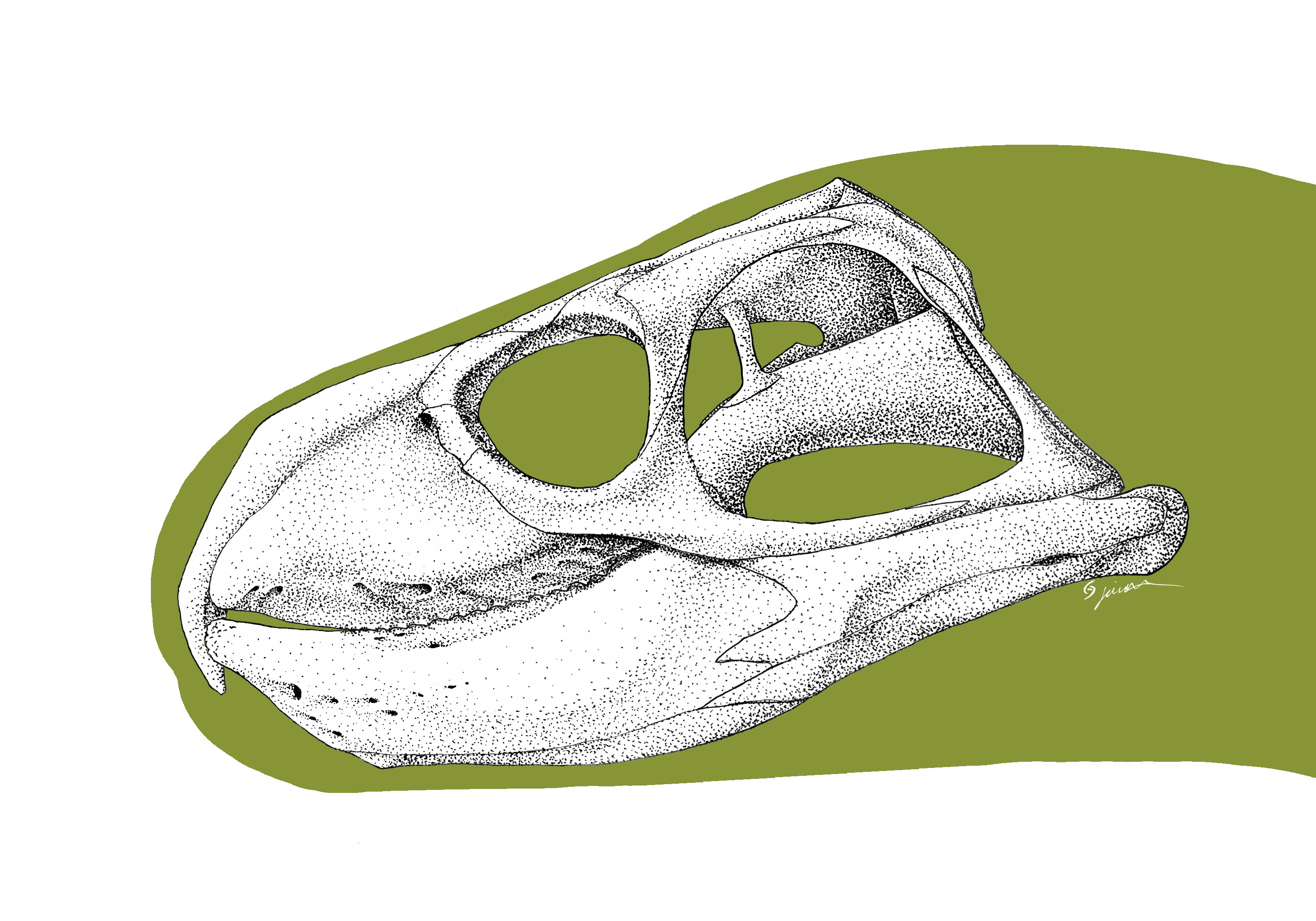|
Rhynchosaur
Rhynchosaurs are a group of extinct herbivorous Triassic archosauromorph reptiles, belonging to the order Rhynchosauria. Members of the group are distinguished by their triangular skulls and elongated, beak like premaxillary bones. Rhynchosaurs first appeared in the Early Triassic, reaching their broadest abundance and a global distribution during the Carnian stage of the Late Triassic. Description Rhynchosaurs were herbivores, and at times abundant (in some fossil localities accounting for 40 to 60% of specimens found), with stocky bodies and a powerful beak. Early primitive forms, like '' Mesosuchus'' and '' Howesia'', were generally small, typically lizard-like in build, and had skulls rather similar to the early diapsid ''Youngina'', except for the beak and a few other features. Later and more advanced genera grew to up to two meters in length. The skull in these forms were short, broad, and triangular, becoming much wider than long in the most advanced forms like '' Hype ... [...More Info...] [...Related Items...] OR: [Wikipedia] [Google] [Baidu] |
Hyperodapedon Sanjuanensis (2)
''Hyperodapedon'' (from , 'above' and , 'pavement') is an extinct genus of rhynchosaur reptiles which lived during Triassic, Late Triassic period. Like other rhynchosaurs, it was an heavily built Archosauromorpha, archosauromorph, distantly related to archosaurs such as crocodilians and dinosaurs. ''Hyperodapedon'' in particular was part of the subfamily Hyperodapedontinae, a specialized rhynchosaurian subgroup with broad skulls, beaked snouts, and crushing tooth plates on the roof of the mouth. ''Hyperodapedon'' remains one of the most widespread and well-understood rhynchosaurs due to its abundance of fossils on several continents. It was named and discovered by Thomas Henry Huxley in 1859, based on ''H. gordoni'', a species from Scotland. It has also been reported from Africa, Asia (India), and North and South America, though some species were later Lumpers and splitters, split off into their own genera. An Indian species, ''H. huxleyi'', is also known by the genus name ''Par ... [...More Info...] [...Related Items...] OR: [Wikipedia] [Google] [Baidu] |
Scaphonyx
''Hyperodapedon'' (from , 'above' and , 'pavement') is an extinct genus of rhynchosaur reptiles which lived during Late Triassic period. Like other rhynchosaurs, it was an heavily built archosauromorph, distantly related to archosaurs such as crocodilians and dinosaurs. ''Hyperodapedon'' in particular was part of the subfamily Hyperodapedontinae, a specialized rhynchosaurian subgroup with broad skulls, beaked snouts, and crushing tooth plates on the roof of the mouth. ''Hyperodapedon'' remains one of the most widespread and well-understood rhynchosaurs due to its abundance of fossils on several continents. It was named and discovered by Thomas Henry Huxley in 1859, based on ''H. gordoni'', a species from Scotland. It has also been reported from Africa, Asia (India), and North and South America, though some species were later split off into their own genera. An Indian species, ''H. huxleyi'', is also known by the genus name ''Paradapedon''. Some of the early South American find ... [...More Info...] [...Related Items...] OR: [Wikipedia] [Google] [Baidu] |
Rhynchosaurus
''Rhynchosaurus'' (''beaked lizard'') is a genus of rhynchosaur that lived during the Middle Triassic period. It lived in Europe. It was related to the archosaurs, but not within that group. The type species of ''Rhynchosaurus'' is ''R. articeps''. Michael Benton named two additional species, ''R. spenceri'' and ''R. brodiei'', but they were subsequently renamed '' Fodonyx'' and '' Langeronyx'' respectively.Martín D. Ezcurra, Felipe Montefeltro and Richard J. Butler (2016). "The Early Evolution of Rhynchosaurs". Frontiers in Ecology and Evolution 3: Article 142. doi:10.3389/fevo.2015.00142. Fossils of ''Rhynchosaurus'' have been found in the Tarporley Siltstone Formation (Mercia Mudstone Group) and possibly the Sherwood Sandstone Group of the United Kingdom.''Rhynchosaurus'' at |
Eohyosaurus
''Eohyosaurus'' is an extinct genus of basal rhynchosaur known from the early Middle Triassic (early Anisian stage) Burgersdorp Formation of Free State, South Africa. It contains a single species, ''Eohyosaurus wolvaardti''. Discovery ''Eohyosaurus'' is known solely from the holotype SAM-PK-K10159, a partial skull missing the front end, with associated incomplete lower jaws currently housed at the Iziko South African Museum, Cape Town. The specimen was discovered by Frederik Petrus Wolvaardt in December 2000, loose on boulder-strewn slopes at the base of a cliff, at Farm Lemoenfontein 44, Rouxville District of the Free State Province. It was collected from the middle deposits of the Burgersdorp Formation of Beaufort Group. This horizon belongs to Subzone B of the ''Cynognathus'' Assemblage Zone, dating to the early Anisian stage of the early Middle Triassic period, about 246 million years ago. Farm Lemoenfontein 44 also yielded remains of the archosauriform ''Erythrosuchus a ... [...More Info...] [...Related Items...] OR: [Wikipedia] [Google] [Baidu] |
Mesosuchus
''Mesosuchus'' ("middle crocodile") is an extinct genus of basal rhynchosaur from early Middle Triassic (early Anisian stage) deposits of Eastern Cape, South Africa. It is known from the holotype SAM 5882, a partial skeleton, and from the paratypes SAM 6046, SAM 6536, SAM 7416 and SAM 7701 from the Aliwal North ''Euparkeria'' site. ''Mesosuchus'' is quite small, spanning around 30 cm in length. ''Mesosuchus'' was discovered and named by D. M. S. Watson in 1912. Discovery and naming Bones of ''Mesosuchus'' were first found by David Meredith Seares Watson in 1912 after examining a block of sandstone kept in a private collection of Alfred Brown. This block was found in the middle deposits of the Burgersdorp Formation, in the ''Cynognathus'' Assemblage Zone near the town of Aliwal North in the Cape Province of South Africa. The block of sandstone contained many intermingled partial skeletons of several small reptiles, and after careful sorting, Watson considered the un ... [...More Info...] [...Related Items...] OR: [Wikipedia] [Google] [Baidu] |
Langeronyx
''Langeronyx'' is an extinct genus of basal rhynchosaurid known from the early Middle Triassic (Anisian stage) Bromsgrove Sandstone Formation of Warwickshire, UK. It contains a single species, ''Langeronyx brodiei'', originally included in the genus ''Rhynchosaurus''. ''R. brodiei'' was first described and named by Michael Benton in 1990, but its redescription by Martín D. Ezcurra, Felipe Montefeltro and Richard J. Butler in 2016 recovered it as more closely related to the more advance hyperodapedontine than to the type species of ''Rhynchosaurus'' and thus it was moved to its own genus. The generic name ''Langeronyx'' honors the Brazilian paleontologist Max Cardoso Langer in recognition of his rhynchosaur research, combined with the Greek ''onyx'' (''óνυξ'') meaning "claw", a common suffix for rhynchosaur genera. ''L. brodiei'' is known solely from the holotype, a partial skull divided into the two specimenWARMS G6097/1and NHMUK PV R8495, housed in the Warwickshire Mu ... [...More Info...] [...Related Items...] OR: [Wikipedia] [Google] [Baidu] |
Fodonyx
''Fodonyx'' (meaning "digging claw") is an extinct genus of rhynchosaur from the middle Triassic epoch of Devon in England. Its fossils (25 specimens) were discovered in Otter Sandstone Formation (late Anisian age) and were first assigned to '' Rhynchosaurus spenceri''. This species was reassigned to its own genus, ''Fodonyx'' (the type and only species is ''Fodonyx spenceri'') the holotype of which iEXEMS 60/1985/292 that described by David W. E. Hone and Michael J. Benton in 2008. In 2010, one skull was reassigned to the new genus '' Bentonyx''. It is distinguished from other rhynchosaurs by a single autapomorphy, the ventral angling of the paraoccipital processes. In all other rhynchosaurs these processes angle dorsally or are horizontal. It is not known if this conferred any advantage to ''Fodonyx. Fodonyx'' was between 40 and 50 cm long. Features Skull and lower jaw The two premaxillae are very long and run up over the snout to meet the prefrontals at the orbit. A ... [...More Info...] [...Related Items...] OR: [Wikipedia] [Google] [Baidu] |
Bentonyx
''Bentonyx'' (meaning "Bentons's claw") is an extinct genus of rhynchosaur from the middle Triassic epoch of Devon in England. Its fossil, a well preserved skullBRSUG 27200 was discovered in Otter Sandstone Formation (late Anisian age) and was first assigned to '' Rhynchosaurus spenceri'', that is known from 25 specimens. This species was reassigned to its own genus, '' Fodonyx'', that was first described by David W. E. Hone and Michael Benton in 2008. More recently, this skull was reassigned to this genus by Max C. Langer, Felipe C. Montefeltro, David E. Hone, Robin Whatley and Cesar L. Schultz in 2010 and the type species is ''Bentonyx sidensis''. The Cladogram below is based on work by Martin Ezcurra Martin may refer to: Places Antarctica * Martin Peninsula, Marie Byrd Land * Port Martin, Adelie Land * Point Martin, South Orkney Islands Europe * Martin, Croatia, a village * Martin, Slovakia, a city * Martín del Río, Aragón, Spain * M ... ''et al''. References ... [...More Info...] [...Related Items...] OR: [Wikipedia] [Google] [Baidu] |
Hyperodapedontinae
Hyperodapedontinae is a subfamily of rhynchosaurs within the family Rhynchosauridae. Fossils have been found in Argentina, Brazil, Canada, India, Madagascar, Scotland, Tanzania, the United States, and Zimbabwe. Phylogeny Hyperodapedontinae was erected by Sankar Chatterjee in 1969 as a coordinate name of the family Hyperodapedontidae Lydekker, 1985. Chatterjee (1969) originally named Hyperodapedontinae to include all Late Triassic rhynchosaurs known at that time, ''H. gordoni'', ''H. huxleyi'' and ''"Scaphonyx" fischeri'', and proposed a morphological diagnosis for the clade. ''Scaphonyx'' includes two additional species, ''S. africanus'' and ''S. australis'', all of which are currently believed to be dubious. As noted by Langer ''et al.'' (2000), using Chatterjee' morphological definition would exclude ''Teyumbaita'' and ''H. huenei'' from the clade, and thus it would be nested within ''Hyperodapedon''. To preserve the name, with its original stratigraphical meaning, Langer ''e ... [...More Info...] [...Related Items...] OR: [Wikipedia] [Google] [Baidu] |
Stenaulorhynchus
''Stenaulorhynchus'' (possibly meaning "narrow tube beak") is an extinct genus of hyperodapedontid rhynchosaur known from the Middle Triassic (late Anisian stage) deposits of Tanganyika Territory, Tanzania. It was found in the Lifua Member of the Manda Formation in the Karoo Supergroup. It was named and first described by Sidney Henry Haughton in 1932. The type species is ''Stenaulorhynchus stockleyi'', a beaked herbivore measuring 1–6 meters in length. Description Dentition The teeth of ''Stenaulorhynchus'' were conical, pointed, and composed mostly of dentine, although new unworn teeth may have had a thin layer of enamel. They were set deeply into and fused with the jaw bones. They are arranged with two-to-several rows of teeth on top and only a few on bottom. The middle row of maxillary teeth only occupied the posterior third of the jaw while the other rows extended all the way forwards and sometimes down the crest of the jaw. The teeth at the front of the mouth, by th ... [...More Info...] [...Related Items...] OR: [Wikipedia] [Google] [Baidu] |
Howesia
''Howesia'' is an extinct genus of Basal (phylogenetics), basal rhynchosaur from early Middle Triassic (early Anisian stage) deposits of Eastern Cape of Good Hope, Cape, South Africa. It is known from the holotype South African Museum, SAM 5884, a partial skeleton with palate and partial lower jaws and from two paratypes, SAM 5885 and SAM 5886. It was found in the Burgersdorp Formation of the middle deposits of the Beaufort Group (Karoo Basin) and referred to Subzone B of the Cynognathus Assemblage Zone. It was first named by Robert Broom in 1905 in paleontology, 1905 and the type species is ''Howesia browni'', named after Alfred Brown (palaeontologist), Alfred Brown. ''Howesia'' in a cladogram based on Ezcurra ''et al.'' (2016): References Rhynchosauria Middle Triassic reptiles of Africa Anisian life Fossils of South Africa Fossil taxa described in 1905 Taxa named by Robert Broom Prehistoric reptile genera {{triassic-reptile-stub ... [...More Info...] [...Related Items...] OR: [Wikipedia] [Google] [Baidu] |





